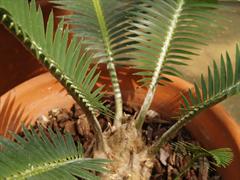
Home Study Palms and Cycads Course
"Identify and propagate palms and cycads. Learn about commercial applications"
- Learn the general cultural practices required to grow palms and cycads
- Learn to propagate, treat pest and disease, manage water and nutrition and more
- Discover how to choose palms and cycads to suit almost any climatic situation;
- Learn to use them in the landscape and other commercial applications.
- Work with palms and cycads in a nursery or garden; get a job or start a business
COURSE AIMS
- Distinguish between the characteristics of different types of palms and cycads.
- Determine general cultural practices, including propagation, for growing palms and cycads.
- Choose palms and cycads to suit different climatic situations.
- Determine treatments for palms and cycads suffering various health problems.
- Specify appropriate landscape applications for palms and cycads.
- Explain different commercial applications for palms and cycads.
COURSE STRUCTURE
There are eight lessons in this course as follows:
1.  Introduction
Introduction
- Scope and Nature of Palm Culture
- Plant Naming
- Species, Cultivars, Varieties
- Characteristics of Palm and Cycad Families
- Botanical Characteristics
- Review of Cycad Genera
- Australian Palm Genera
- Review of Palms
- Sub families, tribes and genera of palms
- Resources
2. Culture
- Cultivating Cycads
- Understanding Soils, Nutrition, pH, etc
- Soil Mixes for Palms and Cycads
- Mulches
- Fertilisers
- Drainage
- Planting
- Water Management
- Pruning Palms and Cycads
3. Propagation
- Overview
- Propagating Palms from Seed
- Propagating Media
- Other Propagation Methods (for some palms); eg. Offshoots, layering)
- Transplanting Seedlings
- Cycad Propagation; seed, offsets, suckers
- Transplanting cycads
- Managing pest and disease
- Propagating Equipment
4. Selecting Suitable Palms and Cycads
- Growth Habits; solitary, clumping, aerial branching, subterranean branching, climbing
 Leaf Types; palmate, pinnate, bipinnate, fan
Leaf Types; palmate, pinnate, bipinnate, fan- Review of palm genera
- Cycad genera
- Cold tolerant palms and cycads
5. Pests & Diseases of Palms and Cycads
- Scope and Nature of Pest Management
- Use of Chemical Legislation
- Common palm and cycad pests
- Common palm and cycad diseases
6. Using Palms and Cycads
- Growing palms in a greenhouse
- What palms can be grown in a greenhouse or conservatory
- Environmental management and plant needs
- Temperature, Ventilation, Light Management
- Landscaping with Palms
- How palms can be used for different affects
- Planting Design
- Preparing a Plan
7. Commercial Applications For Palms & Cycads
- Scope and Nature of Uses for Palms
- Rattan
- Palm Oil
- Dates
- Coconut
- Coir Fibre
- Palms as Indoor Plants
- Species Suited to Indoor Plant Culture
8. Special Assignment
A PBL assignment where you deepen your knowledge by planning the establishment of a collection of different cultivars of palms or cycads (your choice) that are suited to growing in a particular situation or locality.
Research shows that PBL gives the learner greater long-term benefits than traditional learning. Graduates of PBL courses advance faster and further in their careers.
Other benefits of PBL:
-
Develops critical and creative thinking;
-
Creates effective problem-solvers;
-
Increases motivation;
-
Encourages lateral thinking;
-
Improves communication and networking skills;
-
Is based on real-life situations.
WHAT YOU WILL DO IN THIS COURSE
Here are just some of the things you will be doing:
- Distinguish between different plant families, including: *Arecaceae *Zamiaceae *Cycadaceae.
- Distinguish between different major groups which the Arecaceae (Palmae) family is divided into.
 Compile a resource file of sources for information on palms and cycads.
Compile a resource file of sources for information on palms and cycads.- Prepare an herbarium collection of fifty palms and cycads.
- Explain two different ways to plant different specified palm or cycads plants.
- Compare growing palms in the ground with growing them in a pot as an indoor plant.
- Explain appropriate techniques for watering palms and cycads in a specified garden, or collection of container plants.
- Develop guidelines for preparing a specified soil for planting a palm in your locality.
- Make a potting media suitable for growing palms or cycads in a 300mm container.
- Evaluate the chemical analyses of five different types of fertiliser to determine their suitability for use on palm and cycad plants.
- Prepare a maintenance program for a palm plantation which, includes: *Soil management *Pest and disease control *Weed control *Pruning *Irrigation *A twelve month work schedule.
- Write a procedure for propagating palms or cycads.
- Summarise common causes for seed failure when propagating palms and cycads.
- Perform tasks associated with propagating a palm from seed, including collecting and germinating seed.
- Identify different environmental zones, in your country on an unlabelled map, which are suitable for growing palms selected from a provided list of twenty species.
- Determine palm and cycad species which are particularly hardy and adaptable to three different environmental zones within your country.
- Determine six species of cold tolerant palms and cycads.
- Prepare lists of five palms and cycads, suited to grow in each of a variety of different situations.
- Determine the pests which commonly occur on palms and cycads in your locality.
- Determine the diseases which commonly occur on palms and cycads in your locality.
- Develop a checklist of things to inspect when making an assessment of the health of palms and cycads.
- Evaluate the health of five different palms or cycads using a plant health checklist, developed by you.
- Specify treatments for three different pests which are common on palms.
- Specify treatments for three common diseases which affect palms.
- Specify treatments for three common problems which affect cycads.
- Compare alternative (ie. non-chemical) methods of treating five common palm or cycad health problems.
- Determine five palm species which have spikes on the foliage.
- Determine five palm species which have no spikes on the foliage.
- Determine ten palm varieties which have distinct foliage colours other than green.
- Determine ten self-cleaning palm species.
- Determine ten palm species which are not self-cleaning.
- Categorise twenty different palm species according to the texture of the foliage, including: *Broad leaves (e.g. fan palms) *Fine textured feather palms *Coarser textured feather palms.
- Evaluate the use of palms/cycads in a garden which incorporates at least three different varieties, commenting on both aesthetics and function.
- Draw a landscape plan, demonstrating aesthetic impact, for a 30 square metre garden bed, where palms and cycads comprise 75% of the total number of plants used.
- Evaluate the use of palms in a commercial interior (e.g. office or shopping complex).
- Develop a procedure for the production of a palm plant in a wholesale nursery, from germinating the seed to the time it is ready for sale.
- Determine how a specified palm needs to be treated differently when grown in a greenhouse.
- Describe commercial farming of palms including the production of coconuts, dates and palm oil.
Tips for Growing Palms in Cooler Climates
Palms can be, and are grown all over the world; even relatively cold climates.
One of the hardiest palms is the Needle Palm (Rhapidophyllum hystrix). Once established, it is reported hardy to temperatures as low as minus 5 degrees Fahrenheit. It does still like the heat of summer though. Some other particularly hardy palms are:
- Nannorrhops ritchiana - survives zero degrees F when established
- Phoenix canariensis - mature specimens grow well in temperate areas such as southern England and Southern Australia.
- Sabal minor - survives zero degrees F when established
- Sabal palmetto (cabbage palm) - survives to 5 degrees F (maybe lower) when established
- Trachycarpus fortunei (windmill palm) - are grown successfully in northern British Colombia (Canada)
- Trachycarpus - several other species will survive low temperatures
- Washingtonia filifera - there are mature specimens growing well in temperatures to zero celsius, but not any real frost or snow.
More about Washingtonia
There are two species, from south-western USA and Mexico. They are widely used as specimen and street tree plantings, tolerating both hot and cold conditions. Position in full sun in well-drained soil. Provide space to spread. Suitable for tubs in open, sunny areas. Seeds germinate within 2 months – plants have deep roots so they should be planted directly into deep pots.
W. filifera (American Cotton Palm). Thick grey trunk to 15m, fronds 1.5m diameter; retains old leaves to give a “petticoat” effect. Tolerates drought, heat and frost.
W. robusta (Cotton Palm). Brown trunk to 35m, fronds to 2.5m diameter; fan leaves with thorns. Popular palm but not considered as hardy as W. filifera.
WHAT NEXT?
Register to Study - Go to “It’s Easy to Enrol” box at the top of the page and you can enrol now.
or
Get Advice – Email us at info@acsedu.co.uk OR
Use our FREE COUNSELLING SERVICE to contact a tutor
CLICK TO CONTACT US